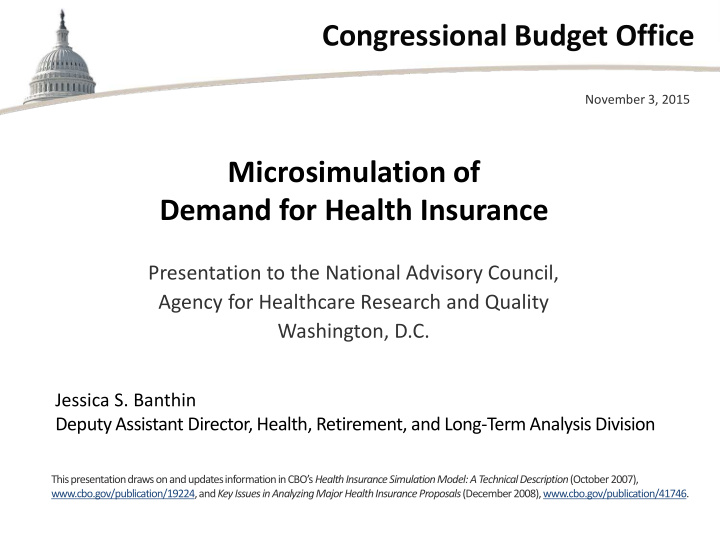



Congressional Budget Office November 3, 2015 Microsimulation of Demand for Health Insurance Presentation to the National Advisory Council, Agency for Healthcare Research and Quality Washington, D.C. Jessica S. Banthin Deputy Assistant Director, Health, Retirement, and Long-Term Analysis Division This presentation draws on and updates information in CBO’s Health Insurance Simulation Model: A Technical Description (October 2007), www.cbo.gov/publication/19224, and Key Issues in Analyzing Major Health Insurance Proposals (December 2008), www.cbo.gov/publication/41746.
CBO’s Health Insurance Simulation Model (HISIM) ■ The first version was developed in 2005 to model various proposals for expanding coverage, including direct subsidies, changes to tax incentives, and insurance market reforms. ■ The model was expanded in 2008, 2009, and 2010 to estimate the effects of additional proposals, including expansion of public programs, individual mandates, and further insurance market reforms, culminating in estimates for the Affordable Care Act (ACA). ■ The model is updated regularly to incorporate new data, the most recent economic forecast, changes in law or regulations, and technical improvements. ■ Baseline estimates are published two or three times a year and are used for estimating the effects of changes to current law. 1 CONGRESSIONAL BUDGET OFFICE
Data Used in HISIM ■ Survey of Income and Program Participation (SIPP)— The base data on individuals and families ■ Medical Expenditure Panel Survey (MEPS), Household Component—For determining individual-level expenditures ■ Medical Expenditure Panel Survey, Insurance Component— A benchmark for private insurance premiums ■ National Health Expenditure Accounts—A benchmark for total spending ■ National Compensation Survey—For grouping workers together into synthetic firms 2 CONGRESSIONAL BUDGET OFFICE
Major Outcomes Modeled by CBO’s HISIM ■ Effects of the ACA’s coverage provisions on the federal budget – Changes in outlays and revenues – Net effect for the current year (2016) and the next ten years (2017–2026) ■ Changes in coverage by source of coverage – Uninsured – Employment-based coverage – Medicaid – Marketplaces (subsidized and unsubsidized) – Other (including nongroup coverage outside of the marketplaces, Medicare, and military health care) ■ Occasional analyses of premiums, individual out-of-pocket spending, and outcomes by relationship to the federal poverty level 3 CONGRESSIONAL BUDGET OFFICE
Advantages of Microsimulation Modeling of Health Insurance Coverage Versus Other Approaches ■ By simulating behavior for each individual and family unit, the estimates capture the distribution of responses rather than average response by cell or subgroup, as in a simpler spreadsheet-type approach. ■ By taking advantage of detailed information collected in household surveys such as the SIPP on individuals and families and the relationships between key variables such as income, health status, employment status, and coverage, the estimates better reflect outcomes under new policies. ■ By using microdata, the estimates capture nonlinear relationships between key variables. 4 CONGRESSIONAL BUDGET OFFICE
Value of MEPS Household Component Data to HISIM ■ Nationally representative data for spending on an individual level ■ Consistent measures of spending across sources of coverage ■ Large number of self-reported demographic, health, and economic characteristics that are useful for imputing to other data sets ■ Methods available to adjust for underreporting of spending on an individual level 5 CONGRESSIONAL BUDGET OFFICE
Value of MEPS Insurance Component Data to HISIM ■ Very large, nationally representative sample of business establishments ■ Much higher response rate than other similar surveys ■ Better representation of small establishments than other surveys ■ Better representation of newly started establishments than other surveys ■ Captures the wide range of premiums offered in the employer- sponsored market 6 CONGRESSIONAL BUDGET OFFICE
Recommend
More recommend